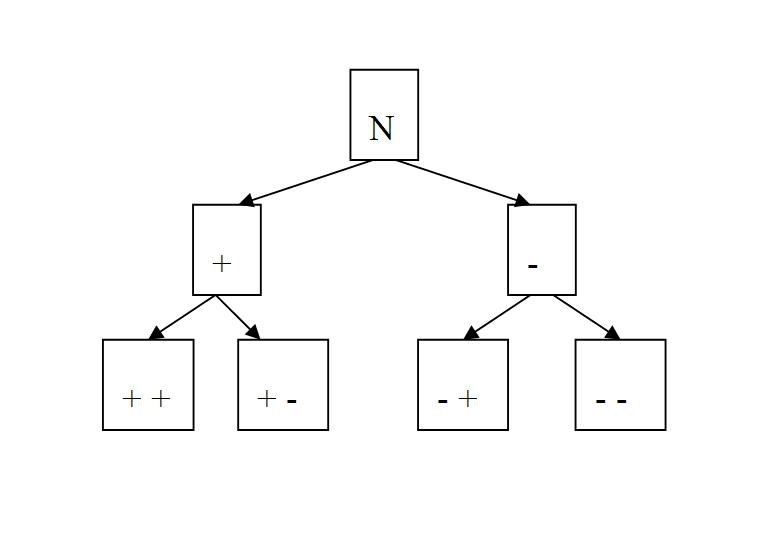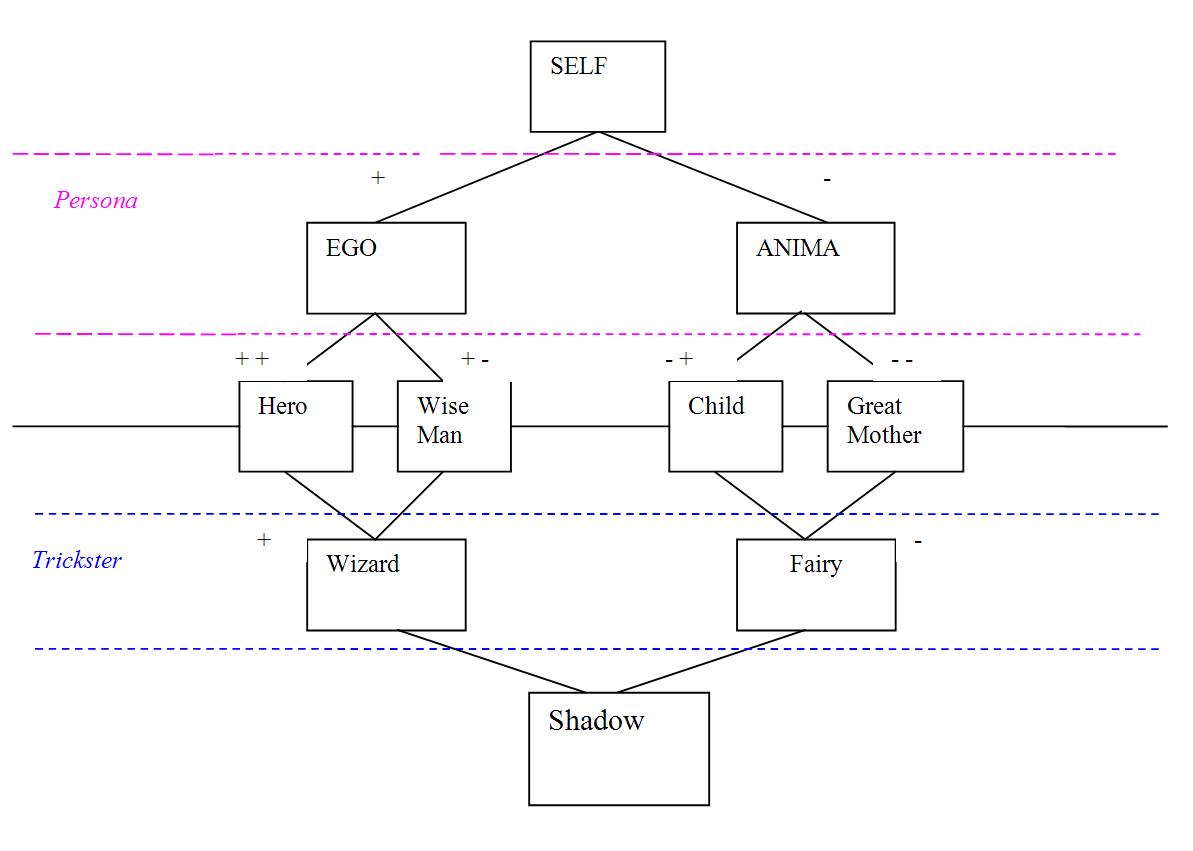Jung’s archetypes as a logical system
ru | enJung’s analytic psychology defines archetypes as basic congenital psychological structures, primordial schemes of fantasy images, located in so called collective unconsciousness and forming a priori activity of imagination.
Archetypes lie in the basic of human symbolism and express themselves in myths, beliefs, dreams, literature, and art. Archetypes are not images themselves but rather their schemes, their psychological background, their possibility.
Jung thought that archetypes had formal rather than substantive characteristics and even those in a rather limited sense. A primary image gains its content when it penetrates into the consciousness, getting filled by the material of experience of the consciousness. Jung compared such a form with a system of crystal axes which in known degree predetermines formation of a crystal in mother water without possessing substantial being itself. Thus mythmaking is a process of transformation of archetypes into images, unintentional utterances of unconscious psychic events in the language of objects of the outer world. In spite of its formality and extreme generality, archetypes have a property of being accompanied by very bright emotion tunes, they impress, inspire, and captivate as they become more distinct, since they go back to universal invariable foundations of the human nature.
Jung believed that archetypes were immanent to the human society or humanity as a whole and were inherited. He created a notion of collective unconsciousness to designate the deepest level of unconsciousness transcending the boundaries of the individual, a reservoir, or world, of archetypes. Such a concept of archetypes calls for attempts to find a set of invariant archetypical structures that characterize the integral properties of the world as a whole.
In later literature the term “archetype” has been used to denote the most general, fundamental, and universal primordial frameworks of ideas lying at the base of all structures in both humanitarian and scientific areas.
There is no comprehensive systematic list of Jung’s archetypes. Jung did not offer a formal scheme but rather added archetypes on an as-needed basis hypothesizing that one archetype can flow into another.
We will try to distinguish the most important Jungian archetypes and group them in a way that reveals relationships between them. Let us first look at how a basic tetrad emerges from the Whole. The neutral whole is differentiated into the masculine and feminine – this is a primary dichotomy.

Fig. 1
The second dichotomy forms a tetrad:

Fig. 2
The second dichotomy achieves an exhaustive reflexive completion of a binary division because it reflects the primary opposition in each of its counterparts. As a result, each of the counterparts, the masculine and feminine, acquires an image of the other counterpart and itself.
The masculine’s image of itself is activity, while its image of the feminine is passivity. As a whole, this pair gives a purely functional view of development: the active MOVES the passive.
On the other hand, the feminine’s image of itself is potentiality, while its image of the masculine is actuality. This pair as a whole gives a purely structural view of development: the potential BEGETS the actual.
The tetrad combined with its mirror image forms a structure that represents a relationship between the individual and collective unconsciousness.
Anima and Animus, two most famous Jungian archetypes, clearly differentiate between psychologies of man and woman. In the context of the primary dichotomy, Anima represents unconscious (feminine) part of the man’s soul, while Animus, represents unconscious (masculine) part of the woman’s soul. This observation makes us to create two separate schemes that group Jungian archetypes – one for man and one for woman.
First, let us consider the masculine version of the scheme.

Fig. 3
The archetype of Self – is a divine project of the man imprinted in his soul. Self “exists” outside of time and space and located above the level of consciousness. In the process of self-identification which is biologically manifested by individual’s gender the whole Self is differentiated into two parts: Ego vs. Anima for men and Ego vs. Animus for women.
The conscious identifies itself with Ego: the man’s conscious identifies itself with the Yang’s part (+) and identifies Anima with the Ying’s part (-) of the soul. The latter one remains mostly unconscious (latent). Mythologically, this process of differentiation of Self into masculine and feminine parts is described in Plato’s Symposium, where the primordial androgens are split into two parts.
Ego, as a Yang’s principle, is differentiated into the active (the Hero) and passive (the Wise Man). Anima, in its turn, is differentiated into the potential (the Great Mother) and actual (the Child). At this level the individual interacts with its social environment selecting for itself one of the four roles; such preference, however, can change depending on the situation. It is important to have in mind that a man selects a role out of all four, even though the masculine roles of Hero and Wise Man are more socially and psychologically acceptable. We consider the set of the four roles as a boundary between the collective and individual unconsciousness. Moving further from Ego and submerging deeper into the collective unconsciousness, we arrive to the archetypes of the Wizard and Fairy.
The archetypal figure of Wizard combines in itself traits of the Hero and Wise Man, which becomes possible due to partial loss of individuality and dissolution in the collective unconsciousness. At the same time, being a reflection of the individual Ego in the space of the collective unconscious, Wizard acquires magical traits. In man’s view, the archetype of Fairy is a mystical and magnetic figure that combines traits of the Child and Great Mother. The Fairy is a reflection of the individual’s Anima in the collective unconsciousness.
Shadow is a reflection of the archetype of Self in the collective unconscious and demarks a level where individuality disappears and manifests itself as an individual contribution to the resolution of the collective karma.
The feminine version of the scheme:

Fig. 4
Woman, in contrast to man, identifies itself with the Yin’s part of the primary dichotomy, while Animus, its Yang’s part, is pushed out to the woman’s individual unconscious. The level of socialization is represented by the same four archetypal figures, however, the woman’s preferred social roles are those of the Child and the Great Mother. The figure of the Witch is a reflection of the woman’s Ego in the unconscious. Being a reflection of the woman’s Ego and combining traits of the Child and the Great Mother, the Witch has magic powers that come from the feminine erotic energy as an amalgam of ethical and esthetical components. In woman’s perception, the Mefisto figure combines the masculine features of strength and mind.
The archetypal image of the Shadow is analogous to that in the masculine scheme.
Let us consider characteristics of the archetypes from the both schemes.
Self — Shadow pair
The pair of the Self and Shadow is the starting and ending point of the both schemes. In a certain sense, the Self and Shadow contain all the intermediate archetypes, however they are not identical to each other.
The Self means pure individuality, while the Shadow denotes submersion of the individuality into the collective unconscious and its gradual dissolution. The path from the Self to the Shadow represents a transition of the One to the Whole. The One does not have any parts and is non-differentiated, while the Whole is a result of combining of different parts together. From the binary dichotomy perspective, the One is neutral (n) that has neither plus nor minus, while the Whole is a mediator (m) that merges both plus and minus.

Fig. 5
O. Wilde’s “The Picture of Dorian Gray” provides a literature example of the relationship between the Self and Shadow archetypes. The invariable appearance of Gray represents the eternal nature of the Self, while his picture, as the Shadow, combines in itself the karmic consequences of his actions. Notice that while Dorian Gray is an isolated individual, his picture is a cultural phenomenon referring to his collective perception. The picture is located in a separate room under a cover which symbolizes avoiding a direct contact between the Self and the Shadow: their interaction has to be mediated through the intermediate levels.
Another literature example of the pair of Self and Shadow can be found in Robert Louis Stevenson's “Strange Case of Dr. Jekyll and Mr. Hyde”. The asocial actions of Mr. Hyde represent the fact that no ethics exists at the level of the Shadow. The ultimate transition of Dr. Jekyll to Mr Hyde symbolizes dissolution of the consciousness in the Shadow, which turns out to be fatal.
In E. Schwartz’s “Shadow” the interaction between the Self and the Shadow is represented as an outright conflict – they literally confront each other. A problem occurs after the Shadow obtained autonomy and its own power.
Ursula Le Guin's “A Wizard of Earthsea” underlines the beyond-the-world nature of the Shadow: a shadow haunting the protagonist appears after he approaches the world of the dead.
The tetrad of social roles
As can be seen on figure 2, the tetrad of social roles is complete by its construction. Indeed, the main four modes of human behavior – perception, thinking, feeling, and action – can be uniquely matched to the four social roles. The Child’s behavior is focused on perception, the Wise Man’s on thinking, the Great Mother’s on feeling, and the Hero’s on action. The four modes correspond to the four cultural values: beauty, truth, good, and strength.
| Role | Behavior mode | Value | Temperament |
|---|---|---|---|
| Child | Perception | Beauty | Sanguine |
| Wise Man | Thinking | Truth | Phlegmatic |
| Great Mother | Feeling | Good | Melancholic |
| Hero | Action | Strength | Choleric |
You can see the distinction between the masculine and feminine social roles: the masculine roles (Hero, Wise Man) are aimed at expansion, while the feminine roles (Child, Great Mother) seek harmonization.
It is worthwhile mentioning that the archetypes of this level are realized not only at the level of separate individuals but also at the level of institutions, organizations, and even countries.
The suggested schemes effectively exhaust all Jungian archetypes, with two of them, the Persona and the Trickster, appearing to be composite – consisting of several archetypes. These schemes define a structure and nature of relationships between the archetypes.